
A small septic tank system is ideal for spaces with minimal needs, such as a one-to-two-bedroom apartment or guest house. A small septic tank contains 750 or 1,000 gallons. We’ll cover everything that factors into your small septic system cost here.
There’s no one-size-fits-all septic solution


When a home doesn’t have access to a central town or city sewer system, different types of septic systems are usually the solution for waste treatment. Septic designs vary from home to home depending on the size of the lot, soil type, slope of the ground, proximity to nearby bodies of water, climate, and more. This list describes nine types of septic tanks and designs, each with different advantages and uses. Learn more about each before hiring a septic tank company to find the best system for your needs.
When taking on this project, expect questions only a pro can answer. With our network of local pros, you'll get the job done and your questions answered—without the hassle and stress of doing it yourself.
| Type of Septic System | Average Cost |
|---|---|
| Anaerobic | $3,000–$8,000 |
| Chamber | $5,000–$12,000 |
| Drip Distribution | $8,000–$18,000 |
| Aerobic Treatment | $10,000–$20,000 |
| Recirculating Sand | $7,000–$18,000 |
| Evapotranspiration | $10,000–$15,000 |
| Constructed Wetland | $5,000–$12,000 |
| Cluster/Community | Variable |

In an anaerobic septic system, the wastewater from your home flows into an underground septic tank buried in your yard. Once inside the tank, the waste settles into multiple layers, with the heavy solids (known as sludge) sinking to the bottom and a layer of oil, fat, and grease (known as scum) floating to the top. Liquid waste, or effluent, is then pushed into a system of distribution pipes that branch out and slowly release wastewater into an area of land called a drain field.
Drain fields are deep, underground trenches lined with gravel and strong geofabric. Along with natural microbes, these layers filter out contaminants to protect the environment. Because conventional systems are the most common type of septic system for single-family homes, they are relatively easy to repair when needed. Conventional septic tank systems typically cost $3,000 to $8,000.
On the plus side, anaerobic systems are some of the most affordable septic systems on the market. Plus, they don’t need power or chemicals to run, which reduces their ongoing operating costs.
However, anaerobic systems aren’t as efficient as some other types of septic systems (including aerobic ones). They also require a fairly large drain field, which can take up quite a bit of space in your yard.
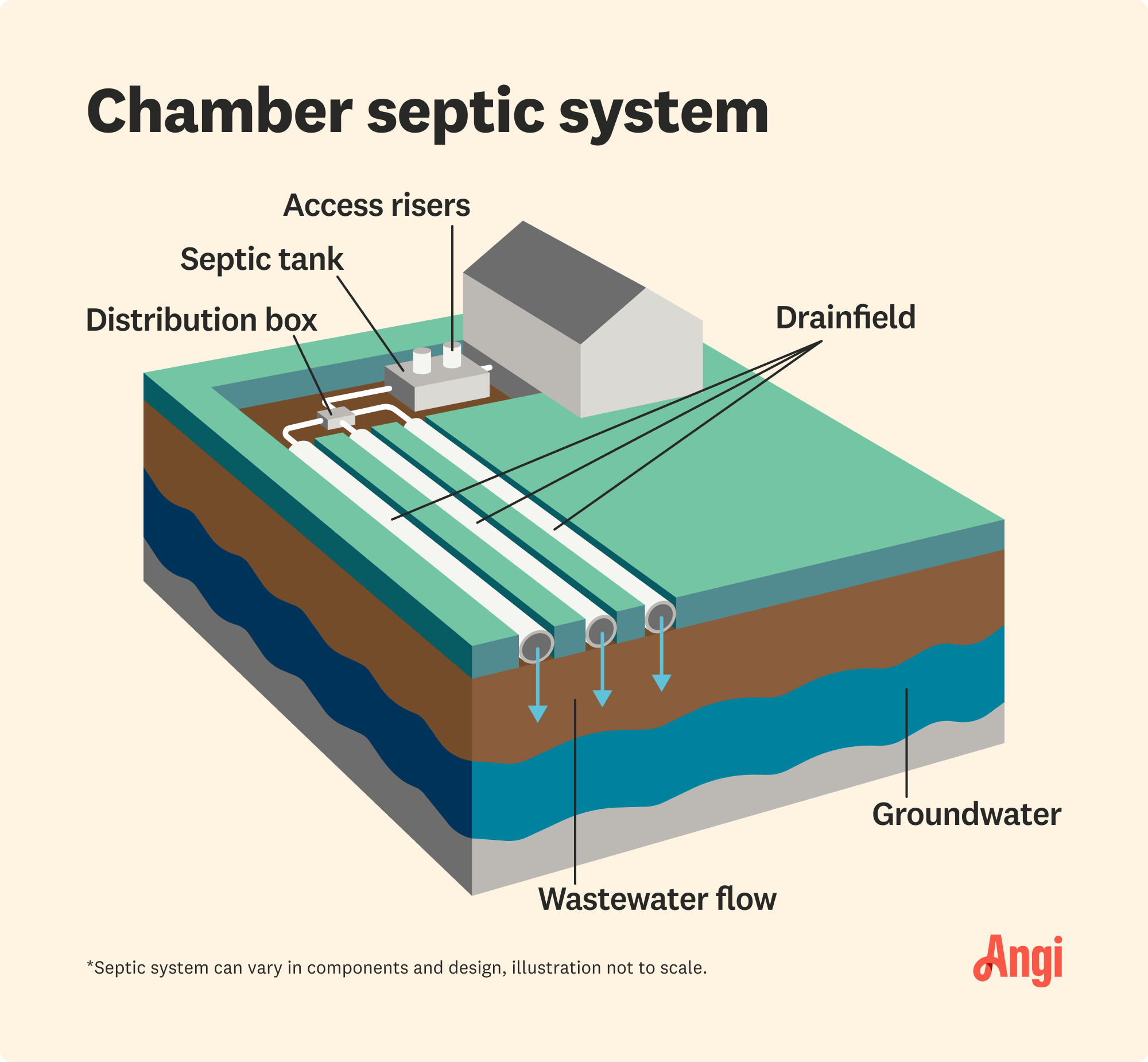
Chamber septic systems are a common alternative to conventional gravel systems in places with a high groundwater table. Instead of using gravel drain fields, these systems consist of a series of connected open-bottomed leaching chambers surrounded by soil. Microbes in the soil around the chambers treat a home’s wastewater before it’s released and travels toward the groundwater.
These systems can be built more easily than conventional systems and sometimes consist of recycled materials, but the added chambers may require extra maintenance. Your local septic tank company can provide exact pricing, but in general, you can expect a chamber system to cost between $5,000 and $12,000.
Chamber septic systems are easy to install and a good option for smaller properties or places where using gravel isn’t feasible (for example, in areas with high groundwater tables or remote regions).
With that said, chamber septic systems have a higher starting price than conventional systems—so they’re not the most affordable option if your property can support an anaerobic system. Also, chamber systems aren’t ideal if you have sandy soil.
Call a pro with any questions you have about your system, even if they're general questions. The more informed you are about your system, the better it will work and the better that pros can help you with it.
Melissa Erickson, Vice President, AAA Dependable Cesspool, Sewer & Drain
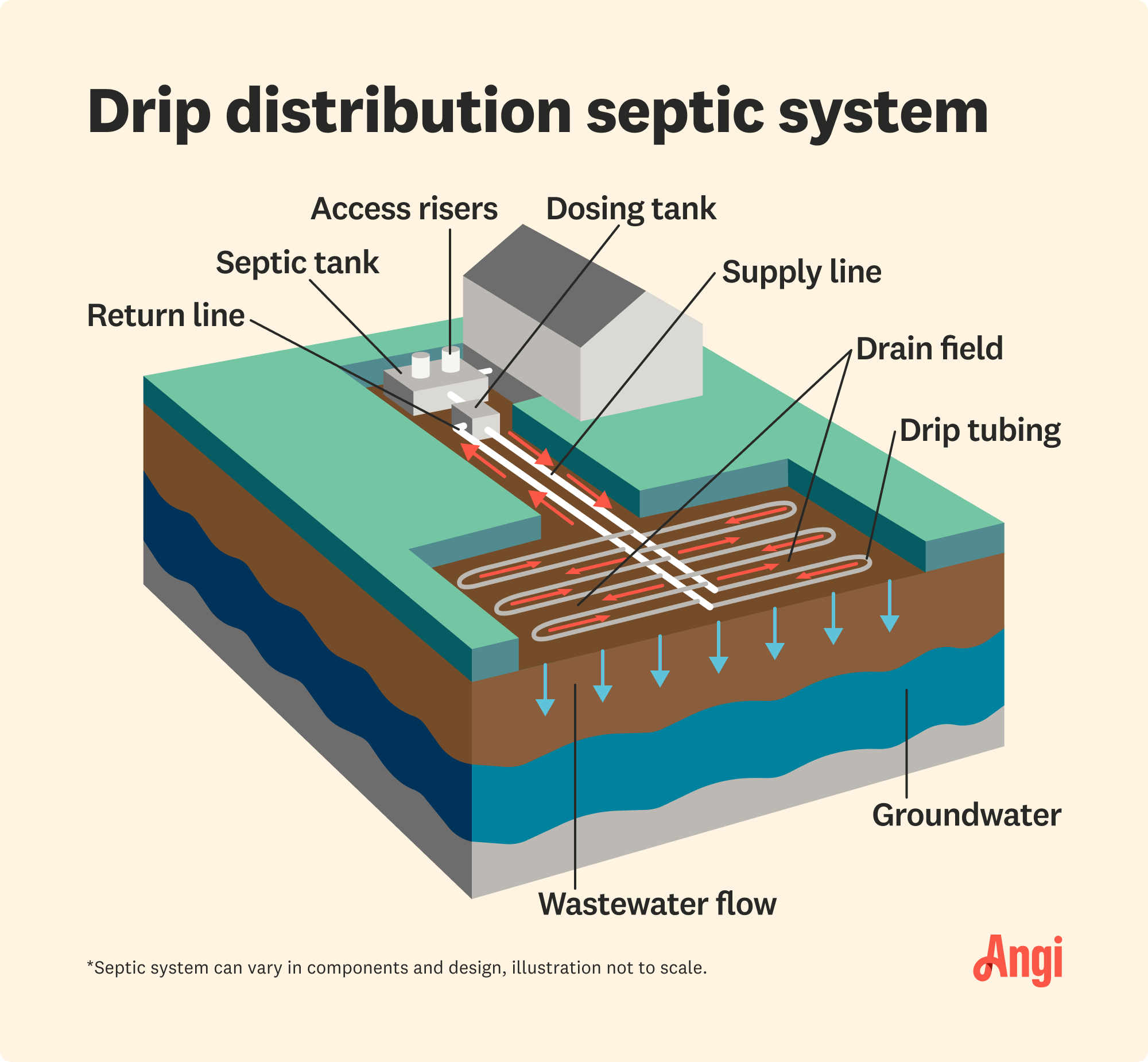
Drip distribution septic systems use a buried network of small tubing to disperse effluent over a large drain field. After the septic tank is a large dose tank that collects wastewater and releases it slowly as the tubes in the drain field empty. This timed release helps avoid overflowing the drain field.
The large dosing tank may require additional maintenance and electrical power to run, making drip distribution more expensive than conventional systems. The small pipes also require filters to prevent large debris from clogging the system. However, the piping is buried in shallow soil and can be convenient to access if needed. Drip systems cost $8,000 to $18,000.
These septic systems are ideal if you have clay soil, shallow soil, or a sloped yard. Drip tubing is buried 1 foot (or less) underground, so you don’t need to dig extensively when installing this type of system.
On the other hand, drip distribution septic systems have a steeper upfront cost than conventional systems. Plus, they may cost more in the long run because they use electricity and have more mechanical components, which could break down and require maintenance.
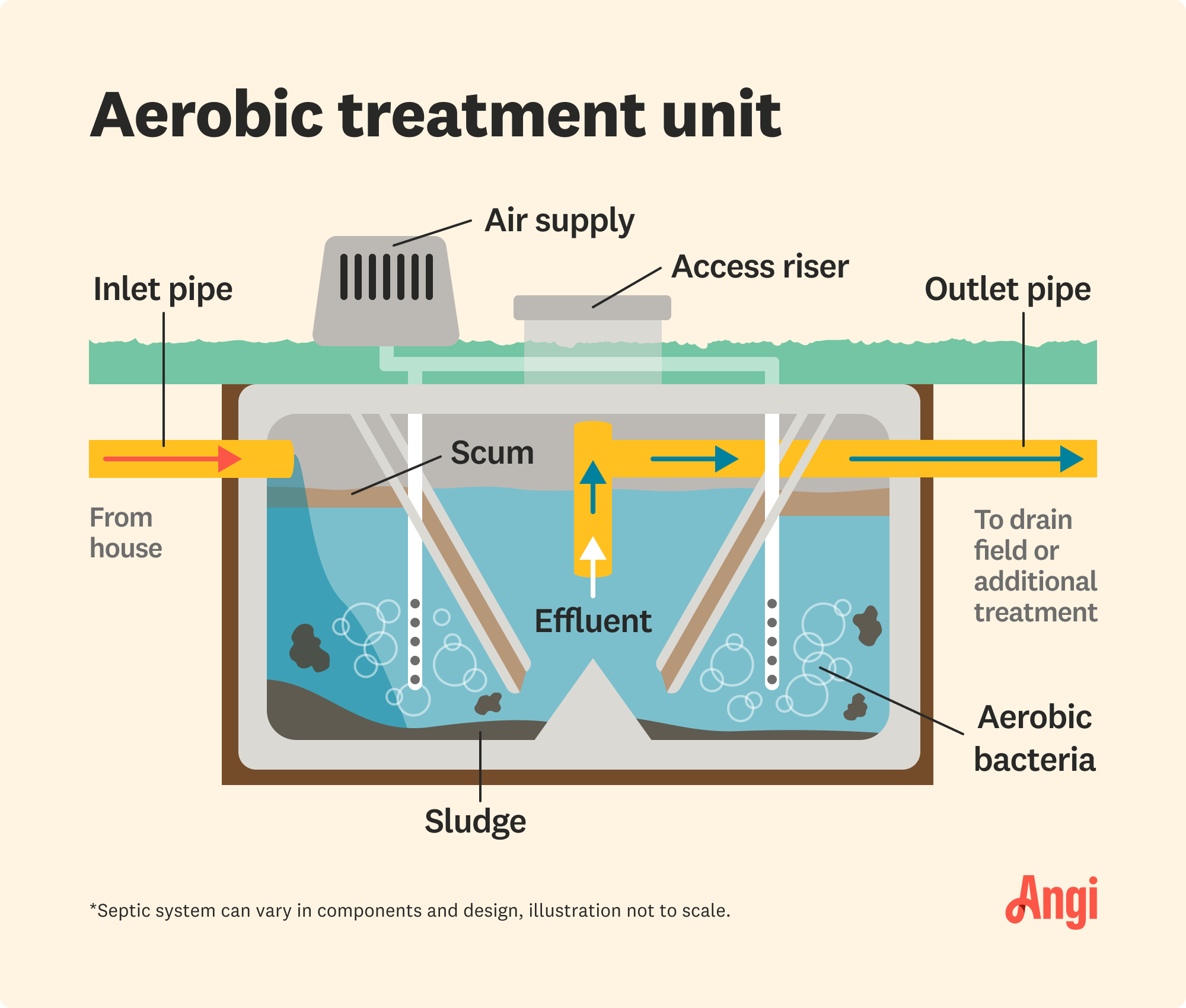
Aerobic treatment units (ATUs) are like small-scale municipal sewage plants. They inject oxygen into the septic tank to increase natural bacterial activity, adding nutrients to the wastewater for treatment. Some aerobic septic systems also have pretreatment and final treatment tanks to disinfect the water before dispersing it into the environment.
ATUs work in homes with smaller lots, inadequate soil conditions, high water tables, or nearby bodies of water that are sensitive to contamination. However, they tend to require regular lifetime maintenance and can be relatively expensive at $10,000 to $20,000.
ATUs are more efficient at breaking down waste than many other types of septic systems (including anaerobic ones), which results in higher-quality wastewater going back into the soil. In addition, these systems are fairly compact, making them suitable for smaller properties.
For many people, the main drawback of ATUs is the price. In fact, they’re one of the most expensive kinds of septic systems to install. And, like drip distribution systems, they run on electricity, which will increase your operating costs.
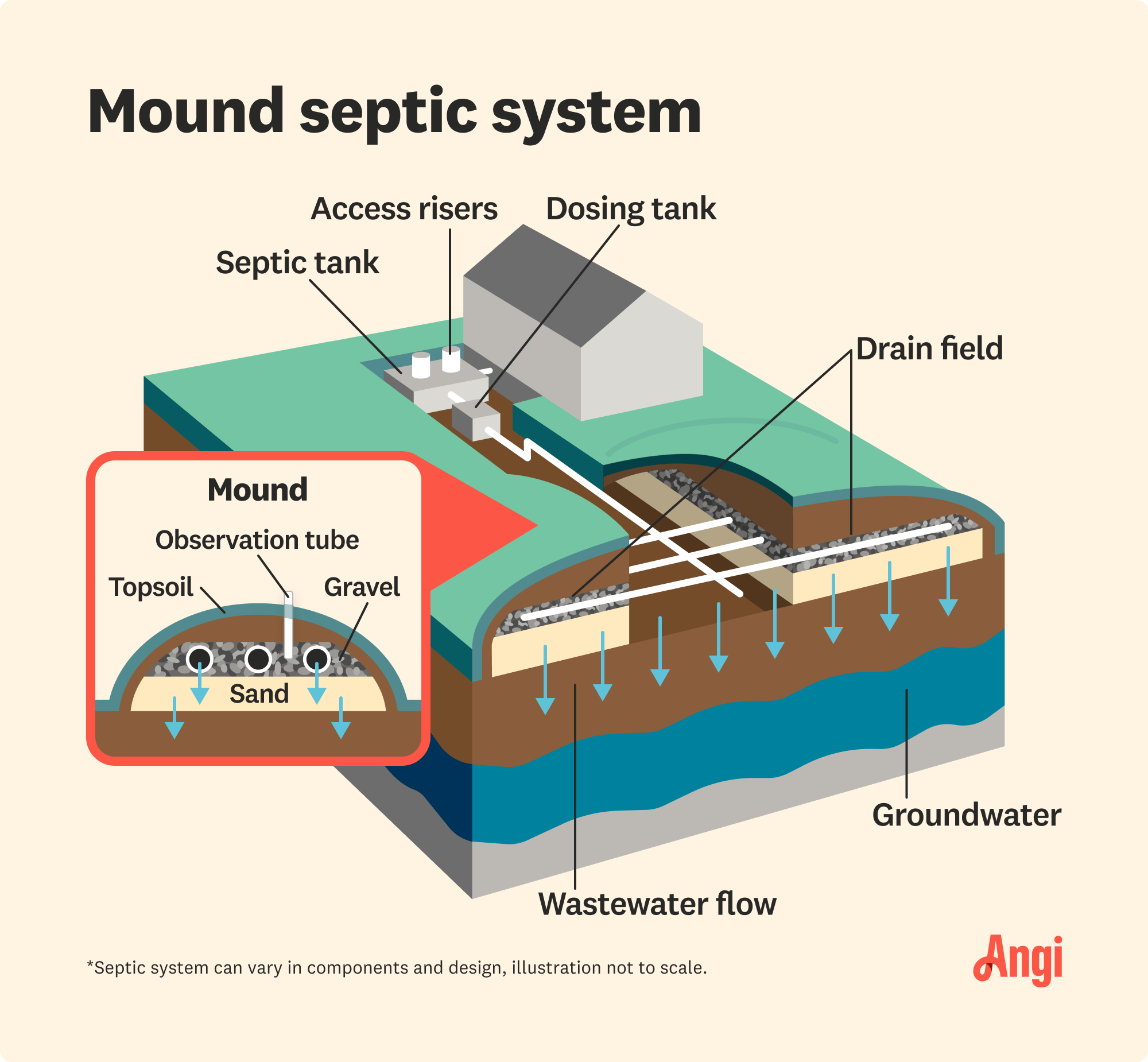
Mound septic systems get their name from a large, raised mound built to contain the drain field. Effluent from the septic tank transfers to a pump chamber that pumps it into a mound of gravel and sand at timed intervals. The effluent filters through the sand and eventually disperses into the soil.
Mound systems are popular in rural areas with plenty of land to build on, but the soil is too shallow for normal dispersal. They require a substantial amount of space to build, and these engineered septic systems cost between $10,000 and $20,000.
Mound systems are useful if you can't dig too far underground—like if you live somewhere with a high water table or dense soil, for example. Their above-ground design ensures that the wastewater in these areas receives enough treatment before going into the ground.
However, along with ATUs, mound systems are some of the most expensive septic systems on the market today. They also take up quite a bit of space.
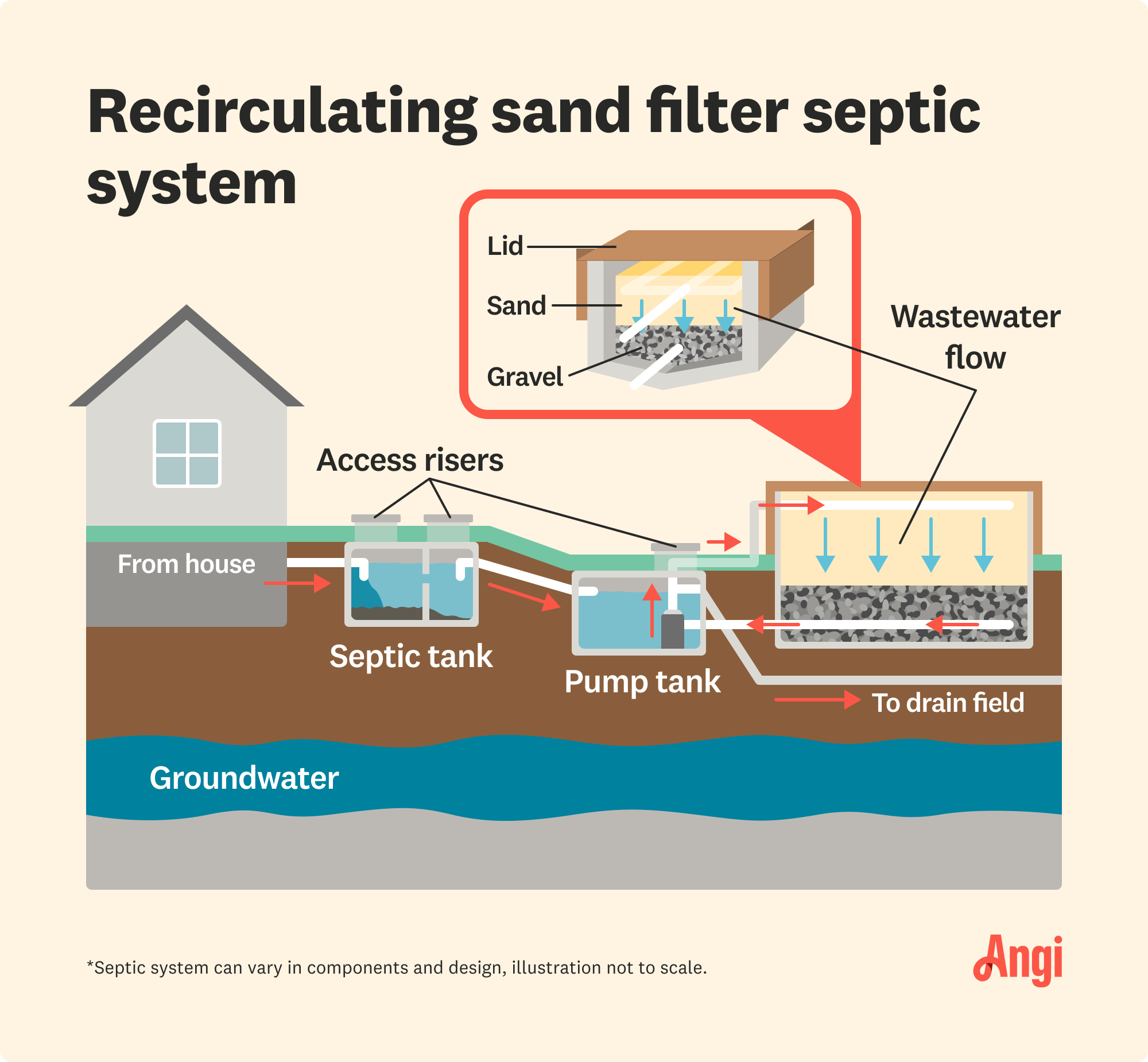
Sand filter systems work above or below ground. Effluent flows from the septic tank to a pump chamber, which pumps it onto the top of a sand filter. The filter is a sand-filled box lined with PVC or concrete. Effluent is filtered as it flows down through the sand and then discharged to a drain field.
Like a mound system, they are good for sites with shallow soil, high water tables, or a nearby body of water. They also require frequent maintenance and are relatively expensive to build at $7,000 to $18,000. However, they can function with much more limited space.
The main pro of recirculating sand filter systems is that they’re suitable to use in areas where conventional septic systems aren’t a good fit. They don’t take up much space, either, so they’re a good option for small lots.
The trade-off is that they’re pricier to install and maintain than anaerobic systems. On top of that, you’ll need to replace the filter on these systems every five years.
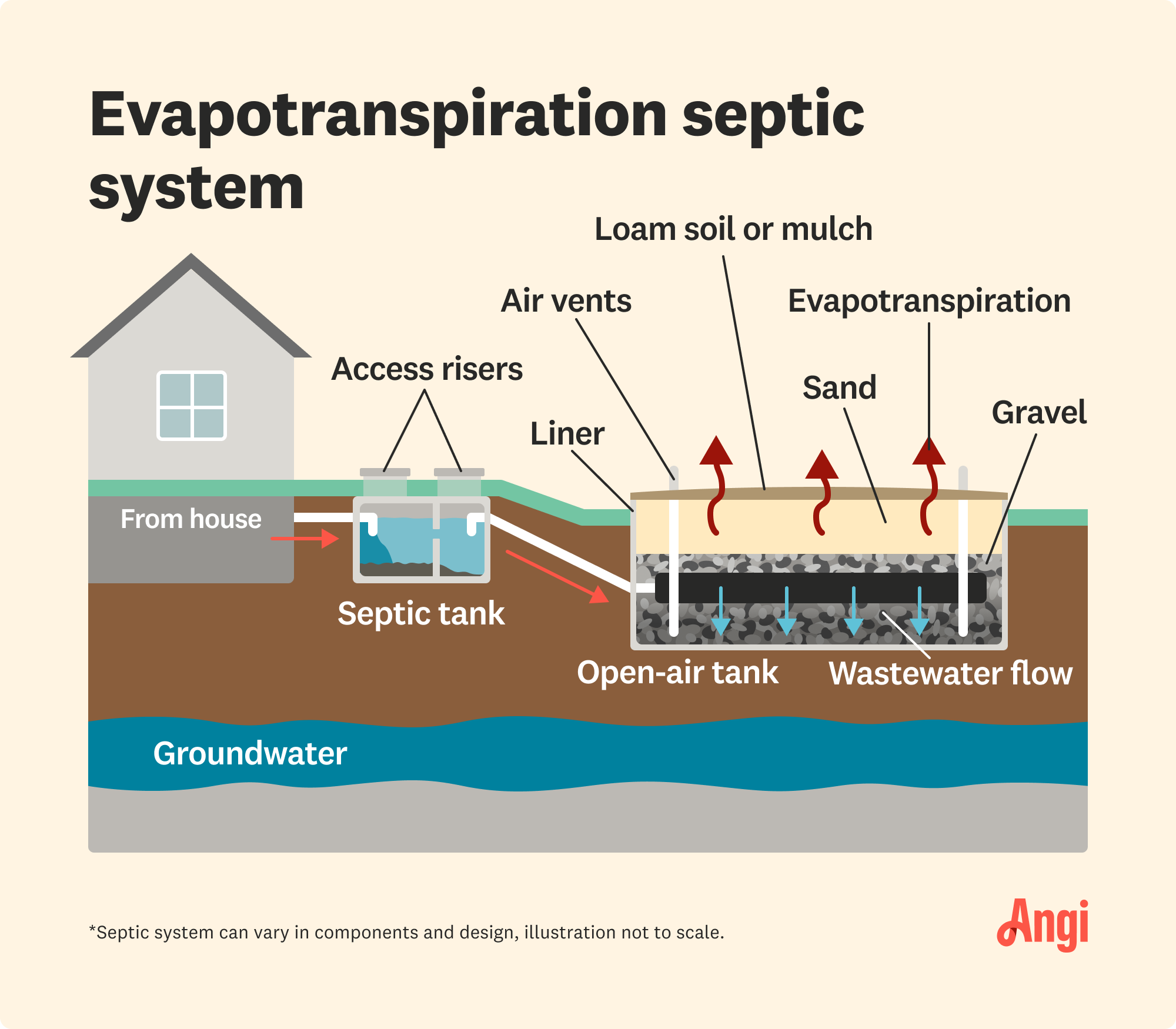
The drain field for an evapotranspiration system is unique among the different types of septic systems. It features an open-air tank lined with a waterproof material that prevents effluent from ever filtering into the soil or reaching groundwater. Instead, wastewater slowly evaporates into the air.
These systems are only useful under very specific conditions. They require a warm, dry climate and plenty of sunlight. Too much rain, snow, or humidity could cause the system to fail. However, installation and maintenance are easy compared to other types of septic tanks. Evapotranspiration septic systems cost $10,000 to $15,000.
Evapotranspiration septic systems are another option if your land has shallow soil. Plus, since the wastewater is designed to evaporate into the air, there’s less risk of it contaminating your groundwater.
The biggest downside of these systems is that they work best in warm and dry environments. If your area regularly experiences wet weather, you’ll need to choose another type of septic system.
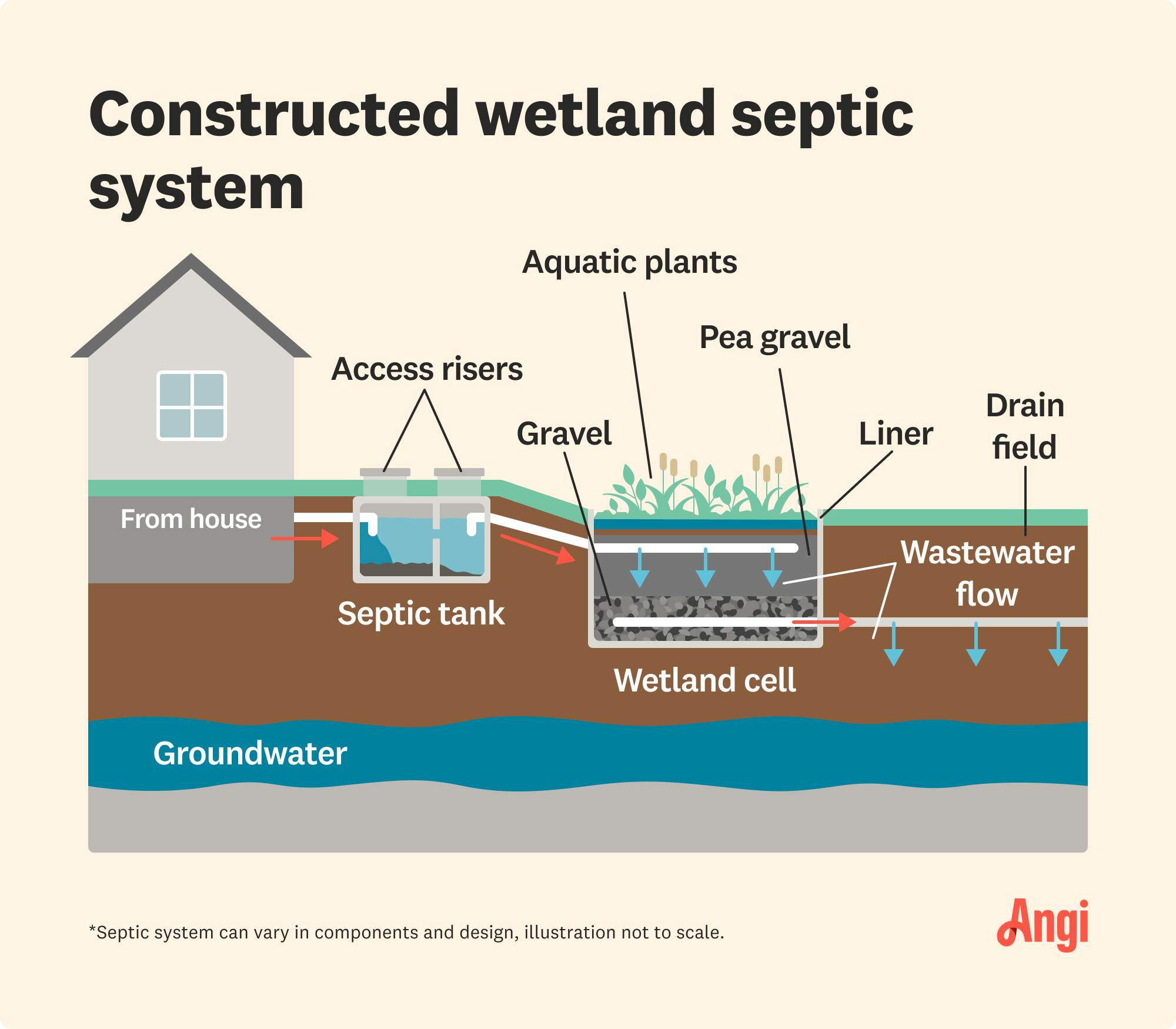
Another unique septic system, a constructed wetland recreates the water treatment processes in natural wetlands. Wastewater flows from the septic tank into a wetland cell made of a watertight liner, gravel, sand, and aquatic plants that thrive in a perpetually saturated environment.
The plants and microbes in the wetland cell break down the wastewater, removing pathogens and nutrients before it flows into a drain field. Built wetland systems cost $5,000 to $12,000.
Constructed wetland systems are a more attractive alternative to other above-ground septic systems since they feature a pond and plants. They’re also more affordable than most other systems, like drip distribution and mound systems.
On the other hand, you’ll need to keep up with regular maintenance (including trimming and weeding the plants). Otherwise, the system may attract mosquitoes and other pests. They also require a large area for installation.
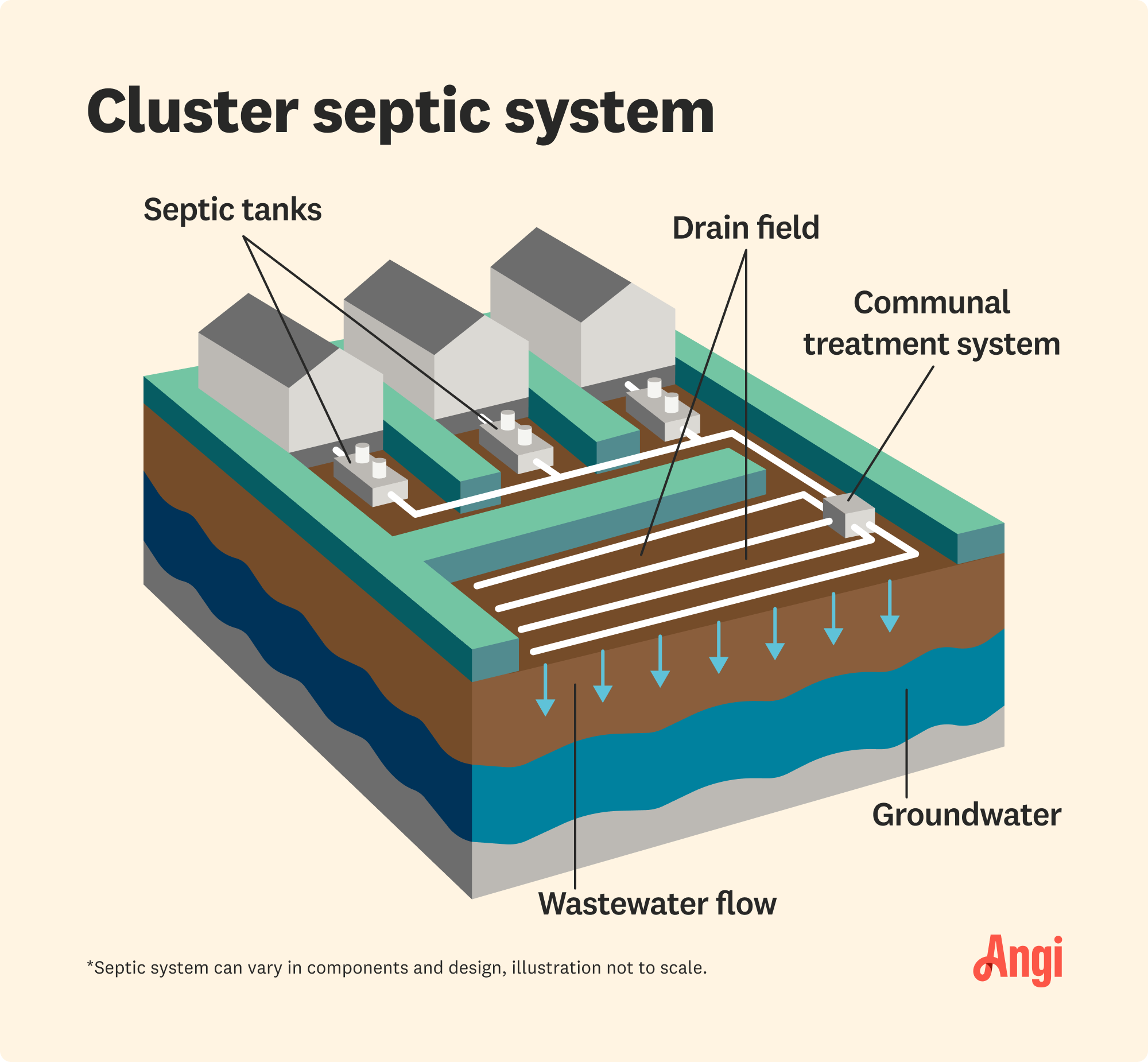
Cluster systems can be built in small neighborhood communities to collect wastewater from two or more homes or businesses.
Each building has its own septic tank for initial treatment before wastewater flows into a nearby common drain field, drip distribution system, or constructed wetland system shared between the community. These systems are most common in rural subdivisions.
If a septic system is the best option for your home, be sure to follow a septic system installation checklist, starting with hiring a septic tank pro.
Cluster septic systems are a cost-effective waste treatment option since they allow multiple households to share maintenance costs. Also, if you live in a rural community, these systems are a great way to pool resources with others in your neighborhood.
With that said, cluster septic systems aren’t suitable for all homes. Also, if there are problems with your septic system, you might have to contact your municipality or work with your neighbors to resolve the issues.
Each type of septic system has pros and cons, so no one type is considered the absolute best. Fortunately, all types of septic systems are capable of doing what they're meant to do: collecting and treating wastewater.
The best septic system for your home depends on your budget, property size, soil type, and climate. For example, if your budget is large and your property is small, an aerobic septic system is likely the best option. On the other hand, if you have a large property and clay or dense soil, a mound system may be the best fit for your needs.
If you live in a community that has a homeowners association, you might not have much choice when it comes to the type of septic system that you have on your property—it will have already been decided for you, and you’ll need to comply if you don’t want to pay steep fines. But if you have a large piece of property in a rural area where your closest neighbor is a mile away and the public sewer system is even farther, you might have some decision-making power with your septic system.
Knowing how important the septic system is for treating household waste, it bears noting that this is not the place to cut corners or search for a bargain. But that doesn’t mean that you have to purchase the most expensive and complex septic system, either.
According to data from Angi customers, 29% of homeowners don’t know if they need a permit for their septic tank installation. Similarly, 28% of homeowners know they need a permit for their project but don’t have one yet. Not sure where you stand? A septic tank pro can give you all the information you need before your installation starts.
From average costs to expert advice, get all the answers you need to get your job done.

A small septic tank system is ideal for spaces with minimal needs, such as a one-to-two-bedroom apartment or guest house. A small septic tank contains 750 or 1,000 gallons. We’ll cover everything that factors into your small septic system cost here.

Need to know what sewer line replacement costs in Kansas City, MO? This guide will help you prepare to budget for sewer line replacement done by local contractors.

How much does a septic system cost? Explore impacting factors, important add-ons, and how you can save money on septic system installation right here.

Knowing your septic tank’s location can help you clean and repair the system quicker. Learn five methods for how to find a septic tank lid with this guide.
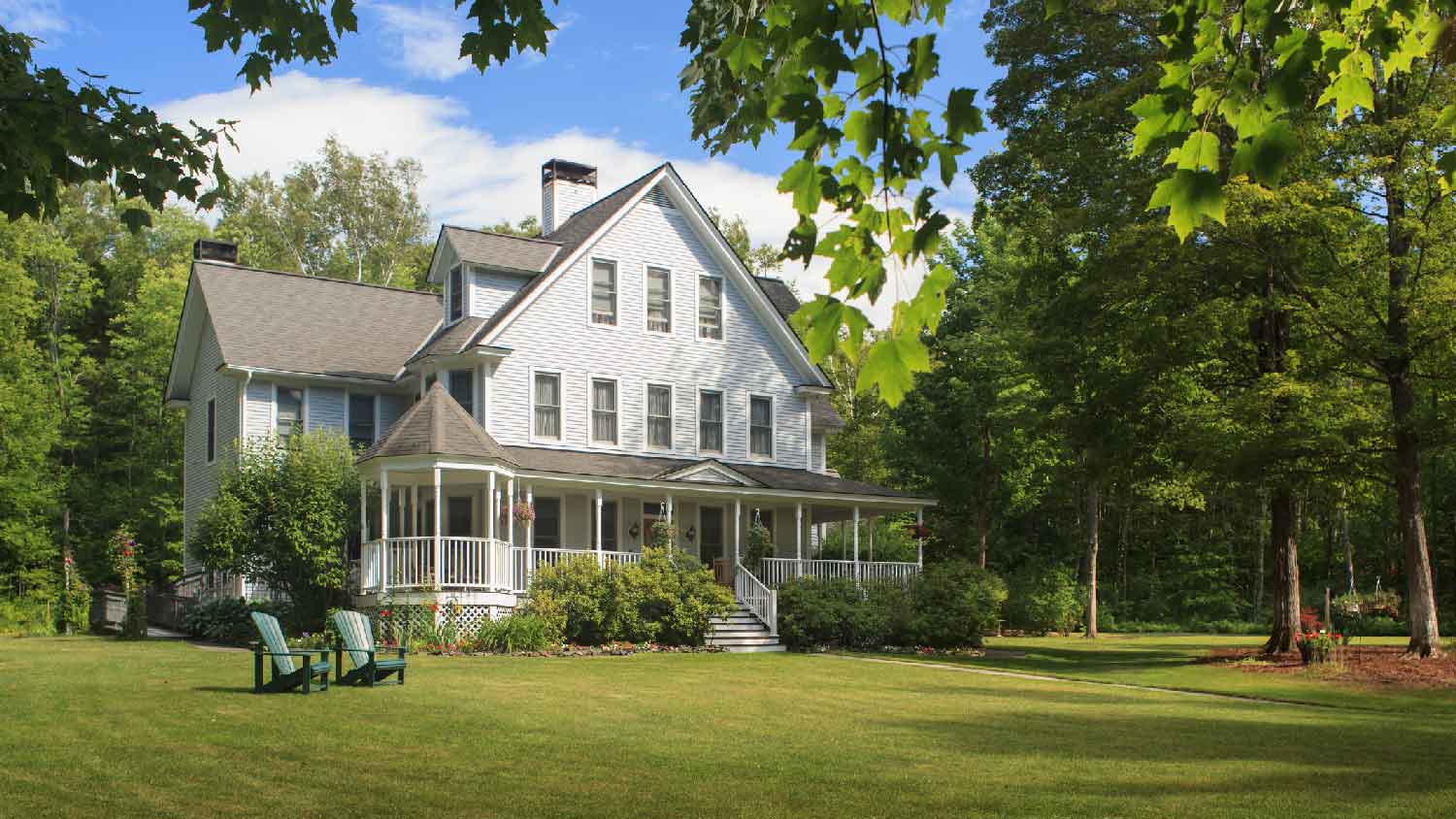
Cleaning out clogged or dirty septic field lines is a quick job for a seasoned pro. Learn what makes up the total cost to clean septic field lines

Want to learn how to build a septic tank for your rural or off-grid property? First, check your local laws, then dive into these general guidelines.